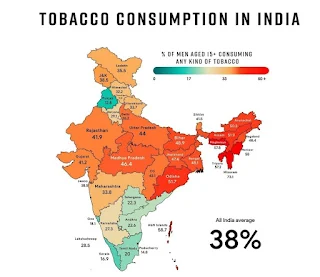Aizawl, 3 June (Zoram News): As World Anti-Tobacco Day is observed, recent surveys indicate a decline in tobacco consumption in India. However, there are concerning findings, particularly in Mizoram.
The second round of the Global Adult Tobacco Survey (GATS) conducted by the Tata Institute of Social Sciences and the Ministry of Health and Family Welfare in 2016-17 revealed a decrease in tobacco consumption among men. The share of male tobacco consumers dropped from 47.9% in 2009-10 to 42.4%.The decline in tobacco consumption was more significant among women, with the percentage falling from 20.3% in 2009-10 to 14.2% in 2016-17.
The National Family Health Survey-5, covering the years 2019 to 2021, showed that around 38% of men and 8.9% of women above 15 years consumed tobacco in India. Chewing forms of tobacco, such as paan masala and gutka, were the most common, with 15% of men using paan masala or gutka, followed by cigarettes (13%), khaini (12%), and bidis (7%). The survey also highlighted that among bidi smokers, about 46% smoked more than five sticks daily.
Among all states and union territories, Punjab and Chandigarh had the lowest rates of tobacco consumption. In Punjab, only 13% of men and 0.4% of women reported tobacco use, while in Chandigarh, the numbers were 12% of men and 0.6% of women.
However, tobacco consumption remains high in Mizoram and other northeastern states. Mizoram tops both the regional and national list with 73% of men consuming tobacco. It is followed by Manipur (58%), Meghalaya (57.8%), Tripura (57.2%), and Assam (51.9%). Arunachal Pradesh also falls into the category of states with over 50% tobacco consumption.
While there is a positive trend of declining tobacco consumption in India overall, the high rates in Mizoram and the northeastern region call for focused efforts to address the issue. Continued awareness campaigns, education, and strict enforcement of anti-tobacco laws are crucial to further reducing tobacco use in the country.

